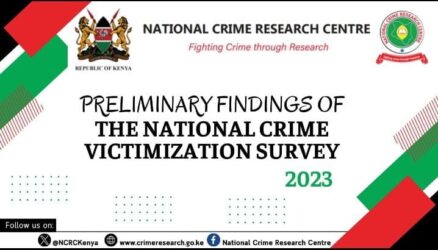NAIROBI Kenya March 6 -Women continue to be the most vulnerable targets for criminals while children are the least vulnerable, according to a research by the National Crime Research Centre (NCRC).
The research released on March 4 also revealed that house breaking and general stealing were the most prevalent crimes and that economic status, gender and age contributed to the vulnerability of the victims of crime.
Unemployment, alcohol and weak law enforcement were identified as some of the factors contribute to crime, according to the report
The NCRC undertook a National Crime Victimization survey to establish the trends of crime victimization in Kenya where it was found that the main victims of crimes in the localities covered were women(77.4percent), men(57.3percent), youths(36.1percent), elderly persons(26.5percent), and children(20percent).
The survey identified factors leading to certain categories of persons being more vulnerable to crime victimization as economic status (75.8 percent), gender (49.4percent), age(41.6percent), lifestyle(36.8percent) social background(17.3percent), literacy status (11.6percent), and marital status(6.2percent).
The findings of the survey established that about 50 percent of the study respondents had been direct victims of crime.
According to the survey, the most prevalent crimes experienced were highlighted as housebreaking (28.5 percent), general stealing (26.6 percent), theft of stock (20.7 percent), burglary (12.9percent), stealing from a person (16.6percent), and robbery with violence (9.8percent).
The NCRC study indicated the consequences of crime victimization as loss of property (84.3 percent), public mistrust and fear (58.8percent), slow economic development of an area (52.2 percent) death (40.2percent), and disability due to injuries (37.4percent).
Crime was found to have resulted in loss of employment, livelihood and income; increased poverty levels; psychological distress; and emotional distress.
The underlying factors which contribute to crime victimization were mentioned as unemployment; availability of alcohol, illicit drugs and substance of abuse; idleness; poverty; and weak law enforcement.
Others are youth peer pressure factors, corruption in the criminal justice system, illiteracy, physical environmental factors such as the absence of street lighting and bushy farm plantations, gender vulnerability factors, ignorance of the law, and local community harboring criminals.
Most of the respondents indicated that most crimes were committed at night while 32 percent of them indicated that there is no specific time of the day for crime occurrence.
Early night, between 7pm and midnight, was identified as the most unsafe hours followed by late night (1am to 4am) and finally midnight.
Over half of the respondents said there was no specific day of the week when crime victimization mostly occurs while 16.2 percent flagged out Saturdays, 9.5percent pointed out Sundays, and 8.4 percent profiled Fridays.
The NCRC is a state corporation under the Ministry of Interior and is mandated to carry out research into the causes of crime, its prevention and to disseminate the research findings and recommendations to the relevant government agencies concerned with the administration of criminal justice and the public.
In October last year, the NCRC also released a report that the main challenges faced by the members of the public in accessing criminal justice in Kenya is corruption and delay in processing criminal matters by the responsible agencies.
The study also revealed that a significant proportion of members of the public are not satisfied with the performance of the National Police Service (NPS) and the Ethics and Anti-Corruption Commission (EACC) in facilitating access to criminal justice in Kenya.
Though most Kenyans know what access to criminal justice entails, a significant proportion of them do not know some of the relevant actors and players in facilitating access to criminal justice in Kenya, including their roles and mandates.
The NCRC recommended enhanced public sensitization about the mandates of the Victim Protection Board, Government Chemist, Witness Protection Agency, Office of the Attorney General, and Office of the Director of Public Prosecution (ODPP).
The study sought to establish the knowledge levels of members of the public on access to criminal justice, members of the public’s perceptions and experiences on the effectiveness of the criminal justice actors in facilitating access to justice, and the challenges experienced by members of the public in accessing criminal justice.
Want to send us a story? Contact Shahidi News Tel: +254115512797 (Mobile & WhatsApp)



